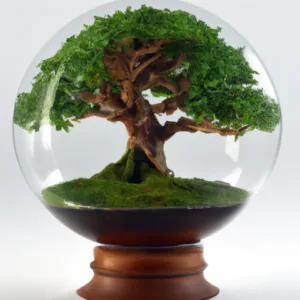Last winter, I found the perfect remedy for the dreary months: a tiny glass world filled with vibrant green moss. While snow covered my garden, this miniature ecosystem thrived indoors.
Creating my first moss terrarium showed me how these small gardens can bring life to any space, no matter the season or weather.
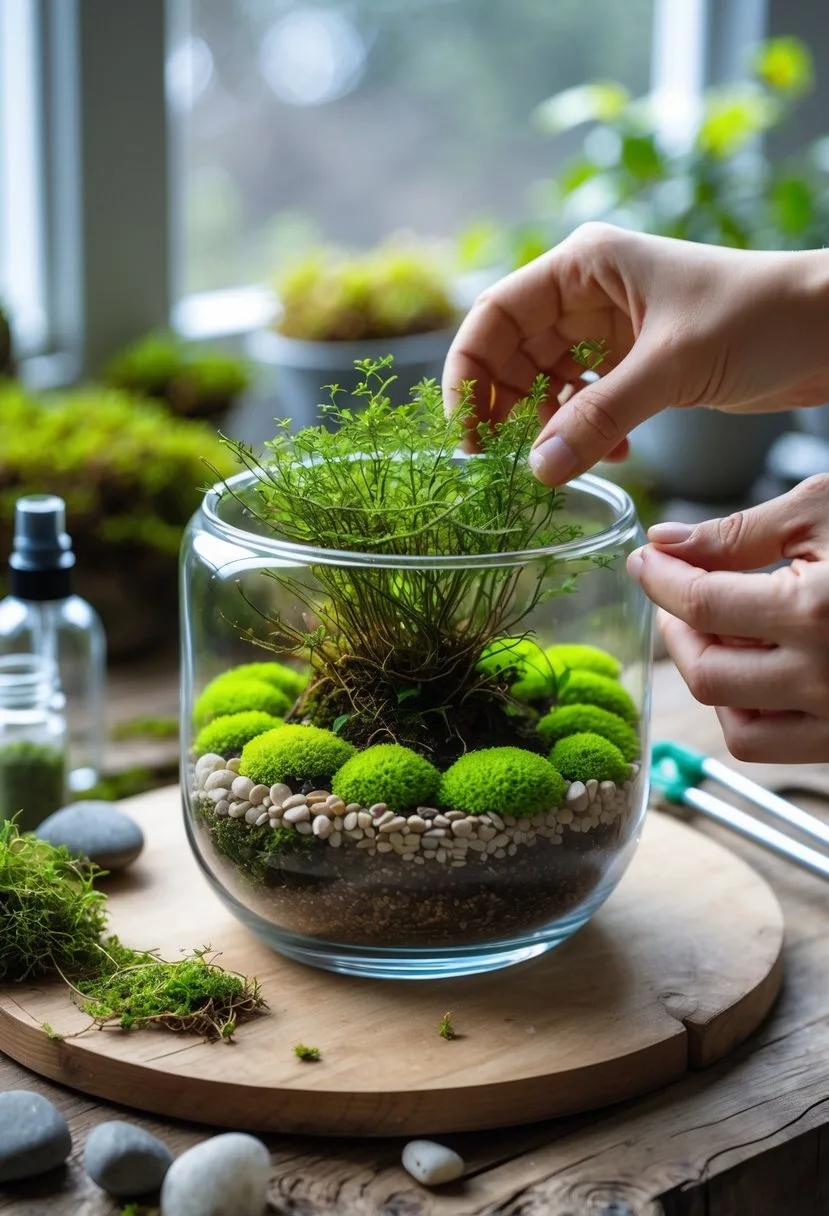
A DIY moss terrarium uses a glass container with a lid, basic materials like soil and stones, and the right moss to create a self-sustaining miniature ecosystem. The process is simple and rewarding, making it perfect for beginners interested in indoor gardening.
This guide teaches you how to select the best moss types for terrariums![]() . You’ll learn how to choose materials, build your terrarium, and display your finished creation.
. You’ll learn how to choose materials, build your terrarium, and display your finished creation.
Key Takeaways
- Moss terrariums are easy DIY projects that create self-sustaining miniature ecosystems in glass containers.
- Success depends on choosing the right moss, proper container selection, and maintaining humidity.
- Regular misting and indirect light keep your moss terrarium healthy.
What Is a Moss Terrarium?
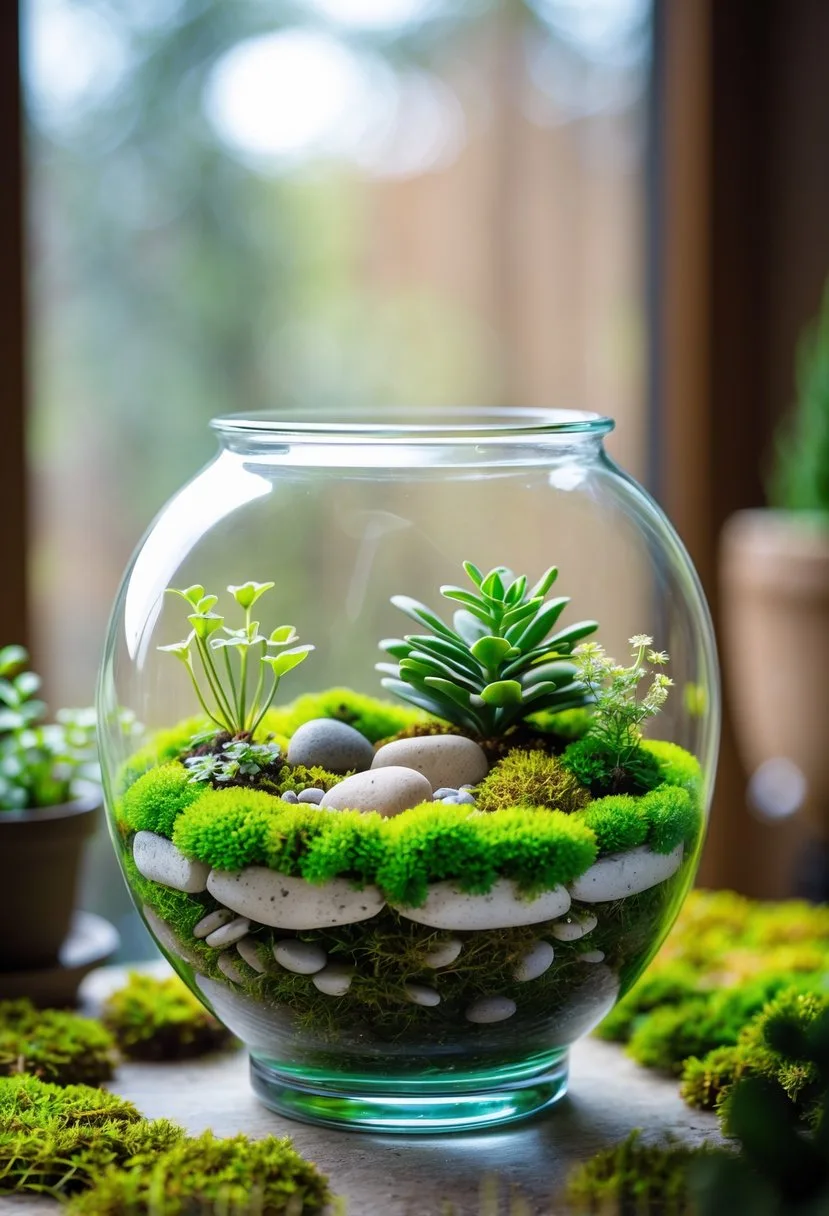
A moss terrarium is a closed or semi-closed glass container that creates a miniature ecosystem where moss thrives in controlled humidity and light. These self-contained gardens bring nature indoors and need minimal maintenance.
Understanding the Mossarium Concept
A mossarium puts moss at the center of the design. I’ve noticed that moss often gets overlooked compared to standard terrarium plants![]() , but it offers unique beauty.
, but it offers unique beauty.
The concept relies on a humid microenvironment within glass walls. Moss absorbs water and nutrients directly through its leaves from the air.
Key components include:
- Glass container with lid or narrow opening
- Substrate layer for moss
- Live moss varieties
- Moisture retention
The closed system forms its own water cycle. Water evaporates from the moss and substrate, condenses on the glass, and returns to nourish the plants.
I use containers that maintain humidity well. The glass acts like a greenhouse by trapping moisture and allowing light to reach the moss.
Benefits of Keeping a Moss Terrarium
Moss terrariums offer several advantages over traditional plant displays. They need less maintenance since the closed environment keeps moisture levels stable.
Primary benefits include:
- Low water needs – The sealed environment recycles moisture.
- Minimal lighting – Moss thrives in indirect light.
- Space efficiency – Great for small spaces.
- Year-round greenery – Moss stays vibrant all year.
I find that moss is generally easy to care for![]() , making it ideal for beginners. Moss rarely needs fertilizer or repotting.
, making it ideal for beginners. Moss rarely needs fertilizer or repotting.
These miniature landscapes can also act as natural air purifiers. Moss absorbs pollutants and releases oxygen, though the effect is subtle in small containers.
Moss adds texture and depth, mimicking natural forest floors or rolling hills in miniature form.
Choosing Moss Types for Your Terrarium
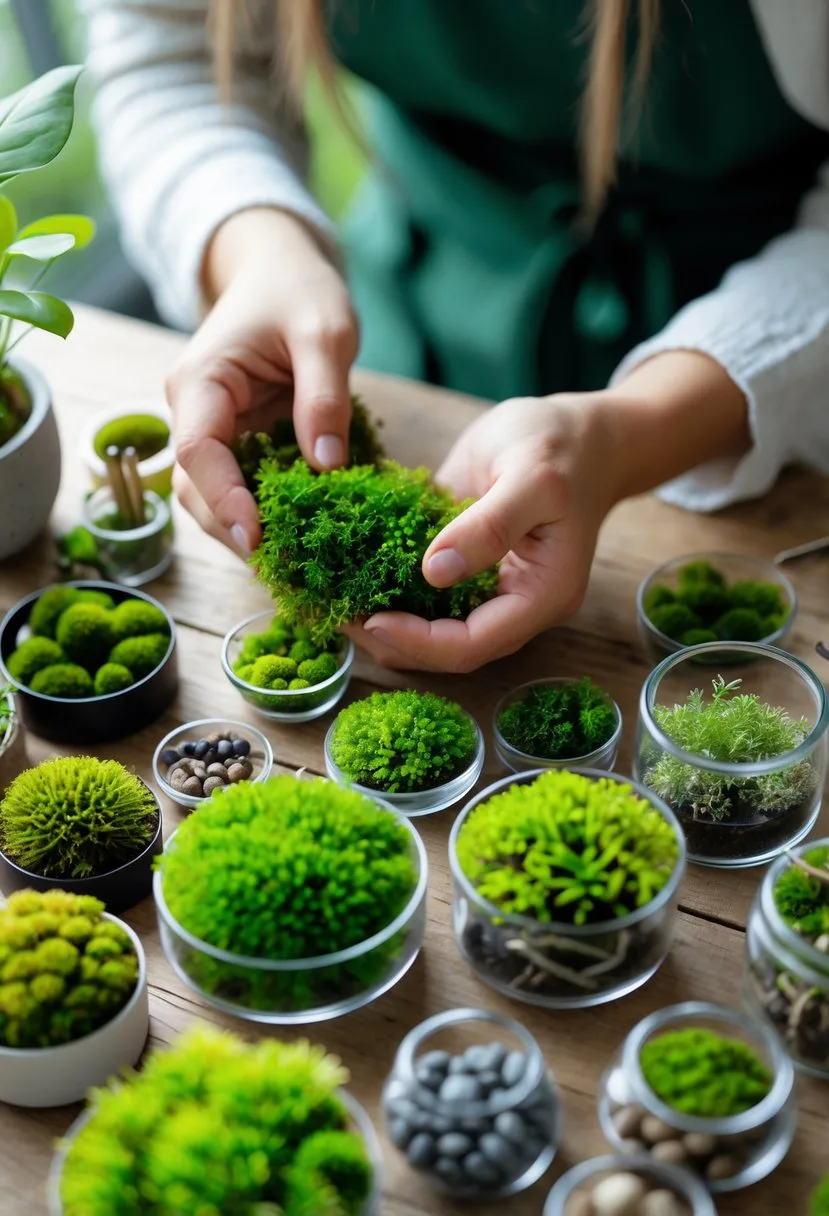
Different moss varieties offer unique textures and growth patterns. I’ll highlight three types that work well for beginners and add visual appeal.
Cushion Moss
Cushion moss forms dense, rounded clumps that add height and texture to terrarium landscapes. This low-maintenance moss![]() grows in compact formations like small green pillows.
grows in compact formations like small green pillows.
I use cushion moss to create focal points in my terrarium. It grows slowly and forms thick, spongy masses that retain moisture.
Key characteristics:
- Growth: Dense, rounded clumps
- Height: 1-2 inches
- Texture: Soft and spongy
- Light: Low to medium indirect light
This moss works best in closed terrariums where humidity stays consistent. I place it where I want to create visual interest without crowding other plants.
Cushion moss tolerates slight drying between mistings. It’s great for beginners because it recovers easily from minor mistakes.
Mood Moss
Mood moss grows in large, feathery clumps![]() and creates a forest-like look in terrariums. Its vibrant green and delicate texture make it a favorite for natural displays.
and creates a forest-like look in terrariums. Its vibrant green and delicate texture make it a favorite for natural displays.
This moss spreads horizontally and fills gaps well. I use mood moss to create ground cover that looks like a miniature forest floor.
Growth requirements:
- Humidity: High (60-80%)
- Watering: Light misting every 2-3 days
- Temperature: 65-75°F
- Substrate: Well-draining soil
Mood moss develops a feathery look when healthy. It needs consistent moisture but can rot if overwatered.
I use this moss in medium to large terrariums where it has room to spread. It pairs well with small plants and helps blend different terrarium elements.
Tree Moss
Tree moss has fine, easy-to-shape foliage![]() , making it perfect for detailed miniature landscapes. Its upright growth looks like tiny evergreen trees.
, making it perfect for detailed miniature landscapes. Its upright growth looks like tiny evergreen trees.
This moss is versatile for terrarium design. I trim and shape it to create specific forms or let it grow naturally for a wild look.
Design uses:
- Creating miniature tree shapes
- Adding vertical interest
- Filling background areas
- Framing other elements
Tree moss grows at a moderate pace and keeps its shape. It needs consistent humidity and tolerates slight air circulation.
I place tree moss at the back of terrariums to add depth. Its upright structure contrasts nicely with low-growing plants.
This moss responds well to gentle pruning. I trim it regularly to keep the desired shape and encourage bushier growth.
Essential Materials and Tools
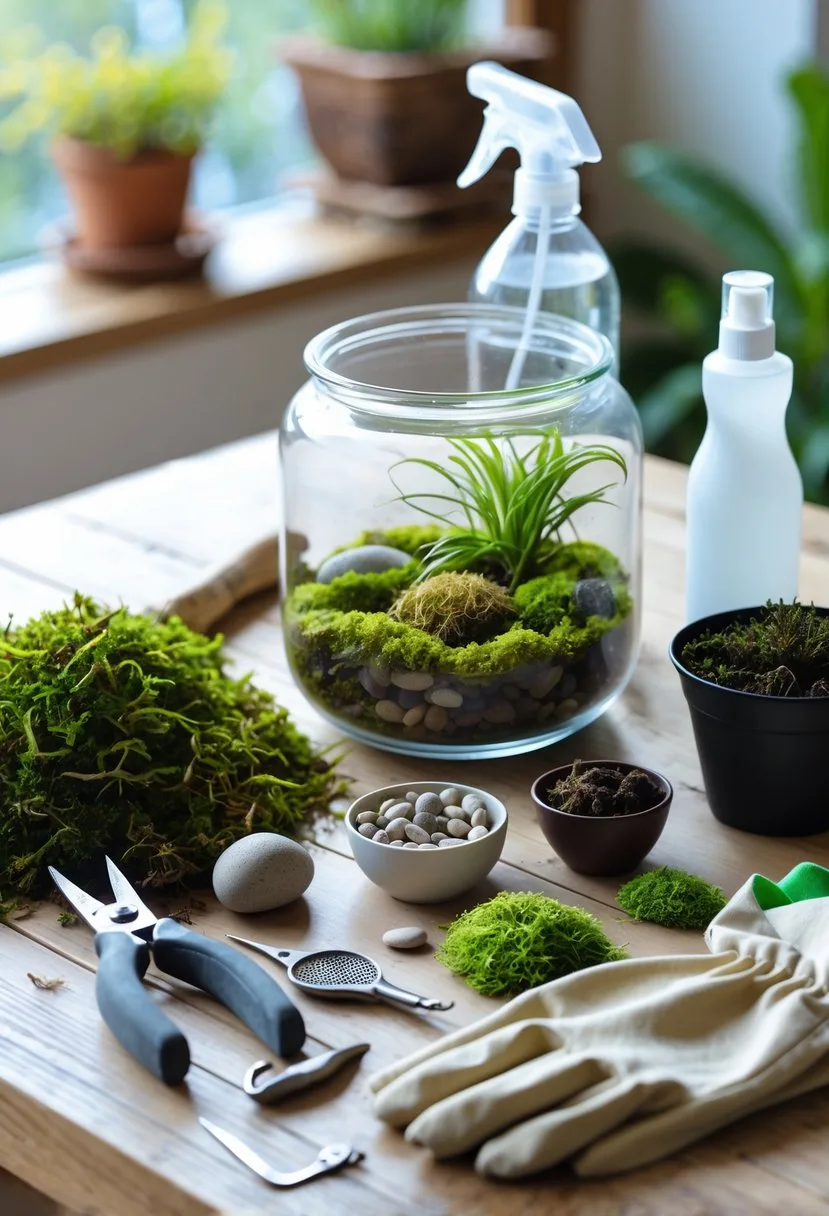
Building a healthy moss terrarium requires specific materials that support drainage, filtration, and plant health. Each part plays a role in keeping your moss thriving.
Selecting the Right Glass Container
I suggest using a clear glass container at least 6 inches wide and 4 inches deep. A wide opening makes it easy to place moss and decorations inside.
Best options:
- Mason jars with lids
- Glass bowls or fishbowls
- Apothecary jars
- Repurposed food containers
The glass should be clear, with no tints or patterns. Colored glass blocks the light moss needs.
I prefer containers with lids to help maintain humidity. If your container lacks a lid, cover it with plastic wrap or glass.
Choose a container at least 8 inches tall. This gives moss room to grow and prevents a cramped look.
Using Activated Charcoal Effectively
Activated charcoal stops bacterial growth and filters water in your moss terrarium. I add about a 1/4 inch layer above the drainage rocks.
You can find activated charcoal at garden centers or online. Make sure it’s labeled for terrariums or aquariums.
Benefits of activated charcoal:
- Removes toxins
- Prevents root rot
- Controls odors
- Keeps water fresh
I spread the charcoal evenly across the bottom layer. The charcoal works well even if the pieces vary in size.
Some guides say![]() charcoal is optional, but I always include it for better long-term health.
charcoal is optional, but I always include it for better long-term health.
Importance of Potting Soil and Substrates
I use a well-draining potting mix made for terrariums or houseplants. Regular garden soil is too heavy and holds too much water.
The soil layer should be 1 to 2 inches deep. This gives moss enough space to establish roots and prevents water from pooling.
Ideal soil:
- Good drainage
- Low nutrients
- pH between 5.0 and 6.5
- Fine texture
Sometimes I mix potting soil with sphagnum moss for better drainage. I use 3 parts soil to 1 part sphagnum moss.
Avoid soils with fertilizer or moisture-retaining crystals. These can cause issues in a closed terrarium.
Incorporating Decorative Rocks and Accessories
I add small decorative rocks at the bottom to create a drainage layer. This keeps water away from moss roots.
Drainage materials:
- Small pebbles
- Aquarium gravel
- Decorative stones
- Clean river rocks
The drainage layer should be about 1 inch deep. I clean all rocks before adding them to avoid contamination.
A spray bottle is essential for keeping the moss moist. I mist the moss lightly instead of pouring water.
Helpful accessories:
- Long tweezers for placing moss
- Small spoon for soil
- Soft brush for cleaning glass
I choose decorations that match the moss’s natural look. Small figurines or colored stones can add character without taking over the design.
Step-by-Step Guide to Making a Moss Terrarium
To build a moss terrarium, you need to layer for drainage, place moss and decorative elements, and keep the moisture level right. Each step helps you create a thriving miniature ecosystem.
Preparing and Layering the Container
I select a glass container with a lid or narrow opening![]() to keep humidity high. Clear glass allows the most light for the moss.
to keep humidity high. Clear glass allows the most light for the moss.
I wash the container with soap and water to remove any residue. Leftover soap or dirt can harm the moss.
I pour in a layer of decorative rocks or pebbles, about 1-2 inches deep. This layer keeps water from pooling at the bottom.
Next, I sprinkle a thin layer of activated charcoal over the rocks. The charcoal helps filter toxins and stops bacteria from growing.
I add 2-3 inches of potting soil on top of the charcoal. Regular potting mix works, but moss prefers slightly acidic soil![]() .
.
I mist the soil with a spray bottle until it feels damp, not soaked. The layers stay visible through the glass.
Arranging Moss and Hardscape Features
I soak sphagnum moss in water for 10-15 minutes to clean and rehydrate it. Then, I gently squeeze out extra water so the moss feels moist but not wet.
I press larger pieces of moss onto the soil surface. Moss does not need deep planting since it has no true roots.
I add decorative stones or driftwood for visual interest. These items create a natural-looking landscape.
I fill gaps between moss with smaller moss fragments. This helps create a seamless carpet across the terrarium floor.
I use tweezers or chopsticks to adjust moss in tight spots. The arrangement should look natural, not perfectly uniform![]() .
.
Misting and Sealing the Terrarium
I spray the terrarium lightly with filtered water. Tap water can contain chemicals that harm moss.
The moss should look dewy, not waterlogged. I watch for water droplets on the glass.
I put the lid on the container right after misting to trap humidity. This creates the greenhouse effect moss needs.
I check the terrarium daily during the first week. Light condensation on the glass means moisture levels are good.
If the glass gets completely foggy, I remove the lid for a few hours to let excess moisture escape. Too much water can cause mold.
I place the sealed terrarium in bright, indirect light. Direct sunlight can overheat the container and harm the moss.
Lighting and Placement Tips
Proper lighting helps your moss terrarium grow well. Moss is sensitive to too much light![]() and needs the right conditions for healthy growth.
and needs the right conditions for healthy growth.
Optimal Indirect Sunlight Placement
I put my moss terrarium near a north-facing window for gentle, consistent light. This spot avoids harsh direct rays.
East-facing windows can work if the morning sun does not shine directly on the container. The light should be bright enough to read by, but not so strong that it heats up the glass.
Best placement locations:
- 3-6 feet from a bright window
- Under fluorescent office lighting
- Near a skylight with filtered light
- On a shelf with reflected sunlight
I avoid dark corners or windowless rooms, since moss still needs some brightness to photosynthesize.
I rotate the terrarium weekly so all sides get equal light. This keeps moss growth even.
Avoiding Heat and Direct Sun Exposure
Direct sunlight can quickly overheat a terrarium and kill moss. Even short periods of sun can raise temperatures above 90°F.
Morning sun through glass is risky because it focuses heat. Just 15-20 minutes of direct sun can damage moss.
Signs of too much light:
- Moss turns brown or yellow
- Extra condensation on glass
- Soil dries out completely
- Moss shrivels
I keep terrariums away from radiators, vents, and electronics to avoid heat spikes.
South and west-facing windows need special care. If these are the only options, I move the terrarium several feet from the window or use sheer curtains.
I check the terrarium’s temperature often. Most moss grows best between 65-75°F.
Maintaining Your Moss Terrarium
Caring for a moss terrarium means keeping moisture balanced, allowing some airflow, and fixing issues quickly. Moss needs low pH, some light, and steady moisture![]() to thrive.
to thrive.
Watering Techniques and Avoiding Overwatering
I use a spray bottle to mist the moss lightly. This gives me better control and avoids overwatering.
Signs of proper moisture:
- Moss looks vibrant green
- Light condensation on glass
- Soil feels damp, not soggy
Overwatering is a common problem. Moss will not thrive in standing water or humidity above 80%![]() .
.
I check the soil by pressing it gently. If water pools, I wait 2-3 days before misting again.
In winter, I mist every 3-5 days. In summer, I mist every 2-3 days as needed.
Cleaning and Air Circulation
I remove dead moss and plant matter with tweezers once a month. This helps prevent mold.
Weekly cleaning tasks:
- Remove brown or yellow moss
- Wipe the glass with a damp cloth
- Clear any blocked drainage holes
I open the terrarium lid twice a week for 30 minutes to let in fresh air. This keeps the air from getting stale.
If condensation builds up, I increase ventilation time. Too much moisture can cause mold.
Activated charcoal in the drainage layer helps keep the terrarium clean between cleanings.
Dealing With Common Issues
Brown moss usually means too much sun or too little water. I move the terrarium to a shadier spot and mist more often.
Common problems and solutions:
| Problem | Cause | Solution |
|---|---|---|
| Mold growth | Poor air circulation | Increase ventilation, remove affected areas |
| Yellowing moss | Overwatering | Reduce watering, improve drainage |
| Slow growth | Not enough light | Move to brighter indirect light |
White fuzzy growth signals mold. I remove affected moss and boost air flow. I clean the spot with a cotton swab dipped in diluted hydrogen peroxide.
If moss dries out, I grind it into powder and mix with buttermilk![]() to help it regrow. This method can revive moss in a few weeks.
to help it regrow. This method can revive moss in a few weeks.
Creative Decoration and Display Ideas
Thoughtful decorations and good placement turn a moss terrarium into a special display. The right accessories and layout make the container look like a tiny world.
Designing Miniature Landscapes
I create depth by using taller moss in the back and shorter moss in the front. This adds perspective.
Decorative rocks help shape hills and valleys. I use larger stones for terrain and smaller pebbles for paths.
The shape of the container affects the design. Wide containers allow for more features, while narrow ones work for simple, upright layouts.
| Container Shape | Best Landscape Style |
|---|---|
| Wide bowl | Rolling hills with multiple levels |
| Tall cylinder | Vertical forest scene |
| Rectangular | Layered landscape with clear sections |
I leave some soil exposed between moss patches for a natural look. This gives moss room to spread.
Incorporating Themed Accessories
Themed decorations![]() set the mood inside the terrarium. I pick accessories that fit the natural scene.
set the mood inside the terrarium. I pick accessories that fit the natural scene.
Miniature figurines create fairy garden effects. I place small animals or houses among the moss, keeping them in scale.
Natural items like twigs, pinecones, or shells add texture. I collect these on nature walks for an authentic touch.
For lighting, I add small LED lights under the moss or around the rim. This makes the terrarium glow, which looks magical with fairy garden themes![]() .
.
Color coordination helps the terrarium match the room. I choose accessories that blend with the space where the terrarium will sit.
Frequently Asked Questions
Making a moss terrarium involves choosing the right materials, picking moss types, and keeping the environment healthy. These questions cover materials, layering, watering, and design.
What are the essential components needed for a moss terrarium?
I use a glass container with a lid or narrow opening to keep humidity in. Moss dries out quickly in open containers![]() , so sealing is important.
, so sealing is important.
The substrate can be simple. I use a basic soil mix with activated charcoal for filtering. Drainage and aeration matter less for moss![]() because it likes moisture.
because it likes moisture.
I add stones or driftwood for decoration and depth. A spray bottle and basic tools help with setup and care.
How do you choose the right type of moss for a terrarium?
I pick live moss, not preserved types. Preserved moss has dyes and chemicals that can harm living moss![]() .
.
Cushion moss forms puffy shapes for hillsides. Fern moss fits forest floor themes. Mood moss grows thick, wavy tufts up to 10cm tall![]() .
.
I check the moss’s natural needs. Most moss prefers acidic soil and moderate humidity. Local moss often adapts best indoors.
Can you explain the process of layering substrates in a closed moss terrarium?
I start with a thin drainage layer if needed. Then, I add activated charcoal to filter toxins.
I spread 1-2 inches of acidic, clay-based soil for moss to attach. Most mosses like dense, acidic soil![]() .
.
I shape the soil for hills or valleys before adding moss. I mist lightly to settle the layers.
What maintenance is required to keep a moss terrarium healthy?
I keep the terrarium in bright, indirect light. Direct sun dries moss![]() , but too little light stops growth.
, but too little light stops growth.
I avoid placing terrariums near heat sources. The glass can trap heat and cause problems.
I trim extra moss with scissors. I use cuttings in new designs![]() . I clean the glass to keep the view clear.
. I clean the glass to keep the view clear.
How often should a moss terrarium be watered, and what are the signs of overwatering?
I use filtered or purified water to protect the moss. Tap water can turn moss brown![]() . In a sealed terrarium, water cycles on its own and needs little help.
. In a sealed terrarium, water cycles on its own and needs little help.
I mist only when moss looks dry or if there’s no condensation inside. Sealed terrariums should stay humid naturally![]() .
.
Signs of overwatering include heavy condensation, standing water, or mold. Brown, mushy moss also means too much water. I cut back on watering and let in more air if this happens.
What are some creative design ideas for setting up a moss terrarium?
I create miniature landscapes by using different moss textures and heights. Cushion moss looks like rolling hills, while fern moss looks like a forest floor.
When I combine these varieties, I add visual interest. Hardscape elements can enhance the scene.
I use driftwood to look like fallen logs or twisted branches. Stones can create rocky outcrops or small mountain ranges.
Small pebbles make riverbeds or pathways. I add springtails to create a bioactive system![]() .
.
These tiny insects eat debris and turn it into nutrients. They help the ecosystem stay balanced.
